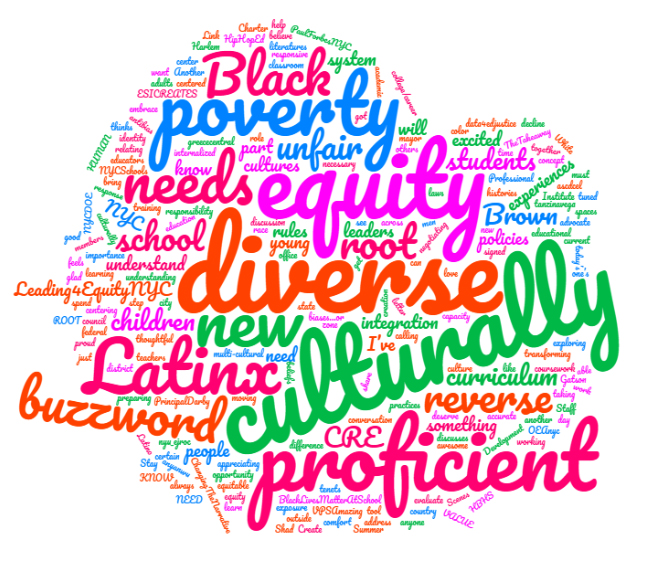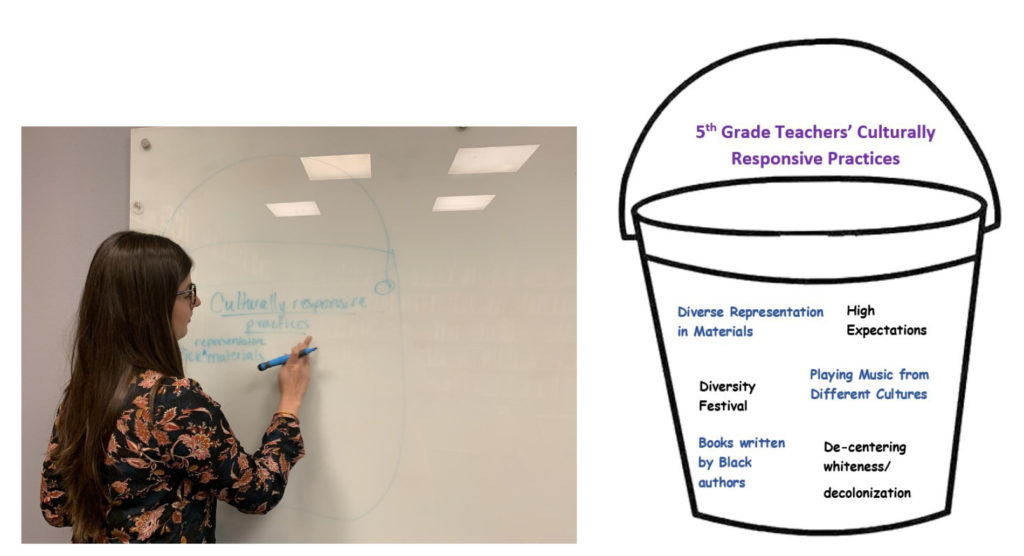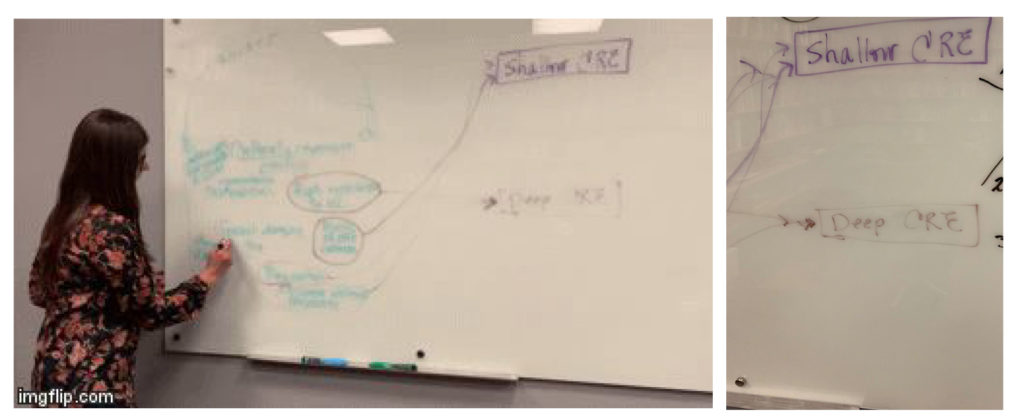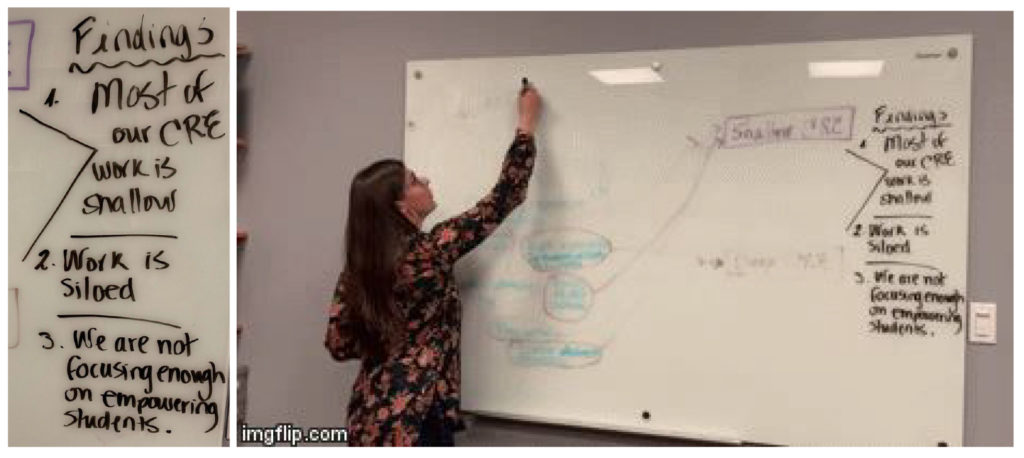Research is a tool that can be used to deepen our understanding about getting to equity. Although researchers are often thought of as academics squirreled away at universities or research centers, teachers should also take on research as part of their responsibility to advance equity in schools. Research can often be most impactful when it comes directly from schools.
NYU Metro Center in partnership with New York City Department of Education’s Mastery Collaborative is researching how two different education models– culturally responsive education (CRE) and mastery-based education (MBE) — converge to center the learning experiences of historically vulnerable students through culturally responsive mastery-based education (CR-MBE). Here, we share one of our research tools (CR-MBE interview questions) that can be adapted for school research use, empowering those most implicated by research to own the research in solidarity with historically vulnerable students.
Our interview questions and your research strategy
We designed the CR-MBE interview questions by drawing connections between culturally responsive education and mastery-based education. The questions focus on understanding mindsets, practices, skills, and school policies capable of sustaining CR-MBE for students. They capture the known and unknown lessons about educational equity that play out in CR-MBE environments.
See both sets of our CR-MBE interview questions
To use the CR-MBE Interviews, establish a team of researchers who will be responsible for coming up with a research strategy. The research strategy should include:
- The Purpose of the Research: What do you want to learn?
- Your Targeted Audience: Who will you interview and why?
- The Interview Process: What will be your approach to interviewing?
- Analyzing Your Data: What do the data you collected tell you about the intersections of CRE and MBE at your school?
- Using the Data and Findings: How will you use your findings to drive educational equity at your school?
We break down this strategy below with suggestions from our team to yours.
Practical purposes for the research
You could conduct this research as:
- A self-assessment or as a reflective tool to assess your alignment with culturally responsive and/or mastery-based philosophies
- A conversation starter for professional learning communities (PLCs) or in professional development (PD) time to identify growth areas and set goals around how mindsets translate to practices, such as in text selection or classroom or school-wide accessibility
- A basis for you to initiate or continue conversations within your school about how
to employ a mastery-based approach within a school oriented toward cultural responsiveness
Your targeted audience
While it’s important to identify who you will interview and why, it’s equally important to identify who won’t interviewed and why. Here are a few other questions to consider while defining your target audience: Does this audience give you diverse perspectives that are necessary to get an understanding of CR-MBE at your school? Are vulnerable identities intentionally included in who you want to hear from? What’s your backup plan if people are not available to interview?
The interviewing process
Determine who will be responsible for scheduling and conducting interviews. You could use the interview tools in their entirety, or only use questions from categories in the tool that are relevant to your research. If you use the full interview tools, the Teacher CR-MBE Interview will take approximately 45 minutes and the School Administrator CR-MBE Interview will take approximately 60 minutes. Have a plan for moving the interviewee along if they become long winded. Determine whether your team will audio record interviews (and get them transcribed) or take detailed notes on interviews. Talk with your team about how you will protect teachers’ confidentiality, especially since it’s likely that the teachers in your building know each other. Make sure everyone on the team is on the same page about the interviewing process.
Analyzing your data
After you conduct the interviews, the next step is to summarize responses to the interview questions so that you can interpret them and pull out findings. There are many ways to summarize interview responses, but we’ll talk about two approaches to analyzing your data: Word Clouds and a Bucket and Match approach.
Word Clouds
Word Clouds summarize responses to interview questions by illustrating the frequency with which words are used to respond to an interview question. Small words mean that a particular word came up enough times to be included in the cloud, bigger words mean that a word came up with an even greater frequency. If you input responses to interview questions into a word cloud generator, you can examine how interviewees are responding to each question and even get an exact count. You could even generate separate word clouds to separate your analyses by demographics (e.g., White teacher responses compared to responses from teachers of Color, or compare by grade levels or subject areas).
This Word Cloud is based on 40 tweets tagged as #culturallyresponsiveeducation. It tells us what people are associating most and least with CRE.
“Bucket and Match” Approach
The “Bucket and Match” approach to analysis is a way to group interview responses and then categorize them to glean research findings. The approach consists of three steps:
- Review the collected data: Review responses to each interview question. Determine if you want to analyze findings by individual interview questions, by categories of interview questions, or by initial response patterns that emerged from your review of responses. Title your buckets accordingly (e.g., if you choose to analyze by interview questions, each bucket will represent a question).
- Bucket (or group) similar data: Review relevant responses for each bucket and start to identify common phrases, ideas, or patterns among responses. Add these to the buckets as you go. Be sure to note any responses that are not common but may be important to understanding CRE and MBE at your school.
- Match information in the buckets to overarching categories: Deeply examine the phrases, ideas or patterns represented in each bucket, and match them to broader categories. Here are a few questions to help think through matching:
- How do phrases, ideas, or patterns within each bucket relate to each other? How are they unrelated?
- How do phrases, ideas, or patterns reflect your schools’ culture or attitudes toward CRE or MBE? What parts of CRE or MBE are less or not represented in the buckets?
- Who is directly and indirectly impacted by the implications of the phrases, ideas or patterns written in each bucket? Who benefits most? Who benefits least?
A teacher buckets overarching phrases, ideas, and patterns from her colleagues’ responses to questions about Culturally Responsive classroom practices.
The finalized bucket of overarching patterns shows teachers’ perceptions of how Culturally Responsive practices happen in their classrooms.
After bucketing interview responses, the teacher notices the items in the bucket represent shallow and deep levels of CRE. She matches the bucket items to these two broader categories.
After completing the matching process, the teacher gleans three findings to present to her school.
Using the data and findings
Now that you have conducted your own CR-MBE research, it’s time to reconnect to why you engaged in the research process. What did you learn about the mindsets, practices, skills, and policies at your school throughout the research process? Based on your findings, is your school set up to foster educational equity for vulnerable students and to provide a CR-MBE education?
How you answer these questions should determine your next steps as a school community.
For example, your findings may prompt you to address teacher expectations of all students in alignment with Culturally Responsive Teaching. Your findings could provide close-to-home data to fuel honest dialogues about how deliberately educators in your school think about the inclusion of students of Color, dis/abled students, and other historically vulnerable groups in your practices. Your findings could help you identify ally practices that incorporate CR-MBE, such as by helping craft peer learning activities to share best practices or provide feedback on the alignment of practices to CR-MBE principles using concrete examples.
Engaging with the research tools and activities presented here could play an important role in helping your school community chart an equity-focused path forward. The research process could strengthen your school community through collaboration that shares the ultimate goal of integrating CR-MBE to benefit all your students, especially those who have been most underserved by traditional approaches to teaching and learning.
Now it’s your turn. Conduct your own research within your school building and share your findings with us and connect with others by tagging us at @metro_research, @MasteryNYC, @StudentCntrHub and using #CREandMasteryResearch.
Authors Leah Q. Peoples, Evan M. Johnston, and Pamela D’Andrea Martínez are members of a Student-Centered Learning Research Collaborative-sponsored research team.
This blog was created with support from JFF and KnowledgeWorks’ the Student-Centered Learning Research Collaborative and its funders. Learn more about this work.



